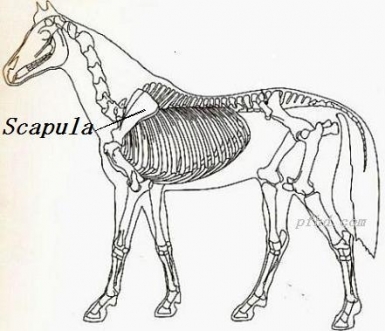Horsezone News
Equine Scapular Fractures: Incidence in Racehorses
 About 2% and 6% of all racetrack fatalities in Thoroughbreds and Quarter Horses respectively are the result of scapular fractures, according to Stuart A. Vallance, BVSc (Hons), who, with Susan Stover, DVM, PhD, Dipl. ACVS, and a research team at the JD Wheat Veterinary Orthopedic Research Laboratory, at the University of California, Davis, has investigated the risk factors for this fracture so that prevention strategies can be developed. Vallance reported his results at the 2010 American Association of Equine Practitioners Annual Meeting, held Dec. 4-8 in Baltimore, Md.
About 2% and 6% of all racetrack fatalities in Thoroughbreds and Quarter Horses respectively are the result of scapular fractures, according to Stuart A. Vallance, BVSc (Hons), who, with Susan Stover, DVM, PhD, Dipl. ACVS, and a research team at the JD Wheat Veterinary Orthopedic Research Laboratory, at the University of California, Davis, has investigated the risk factors for this fracture so that prevention strategies can be developed. Vallance reported his results at the 2010 American Association of Equine Practitioners Annual Meeting, held Dec. 4-8 in Baltimore, Md.
Vallance and his colleagues examined the necropsy reports of 73 Thoroughbreds and 28 Quarter Horses, as reported by the California Horse Racing Board postmortem program. These animals were euthanized after suffering a fractured scapula on a racing surface between 1990 and 2008.
The team discovered, through visual and CT examinations, that fractured scapulas showed signs of stress fractures that resulted in a region of weakness within the bone. Such weakness can predispose the bone to complete fracture when a horse is racing or working at high speed.
They reported that when the exercise histories were compared to those of live matched control horses, Thoroughbreds and Quarter Horses sustaining a scapula fracture had fewer races and works, fewer days in active training, less total distance schooled, and longer layup periods.
"We also found that females were underrepresented in this study," Vallance said, indicating that males were more likely to sustain a scapula fracture. Additionally, Thoroughbred and Quarter Horse racehorses with a scapular fracture were more likely to be 2 years old or 5 years old or more when compared to the racetrack population. The team also noted that the fractures occurred most commonly in the right forelimb.
Quarter Horses sustained most of their scapular fractures while racing, whereas Thoroughbreds sustained most of their fractures while training. The majority of the scapular fracture-related deaths during races occurred in claiming races, with many of them being the horse's first (maiden) race.
The team also reported that while Quarter Horses were more likely to sustain a scapular fracture than Thoroughbreds, the Quarter Horse racing population had a 50% lower incidence of musculoskeletal deaths when researchers considered all fracture types and fatalities.
Vallance believes that scapula fractures are a preventable hazard of racing that can be identified on lameness examination or via nuclear scintigraphy or ultrasound prior to catastrophic fracture.
"Unfortunately, we do not know at this stage why horses with a scapular fracture are not keeping up with the rest of the training cohort," Vallance said. "But it is interesting that the two breeds that have very different race distances are suffering the same fracture."
This study was supported by the Center for Equine Health through a gift from the Patterson Foundation of St. Paul, Minn., and the Dolly Green Foundation Endowment, and made possible by the California Horse Racing Board Postmortem Program conducted through the California Animal Health and Food Safety Laboratory System, UC Davis.
Source: thehorse.com
News Search
Categories
- General
- Event Results
- Stallionzone
- Sponsored Shows
- Clubs
- Health
- Feature Horses
- Competitions
- Five Minutes With Horsezone
- Young Riders
- Reviews
- Training and Clinics
- Postcards from the saddle
- 2014 Equitana by HORSE FIRST
- 2013 Equitana
- 2012 Equitana
- 2012 London
- 2011 Equitana
- 2011 Queensland Floods
- 2010 WEG
